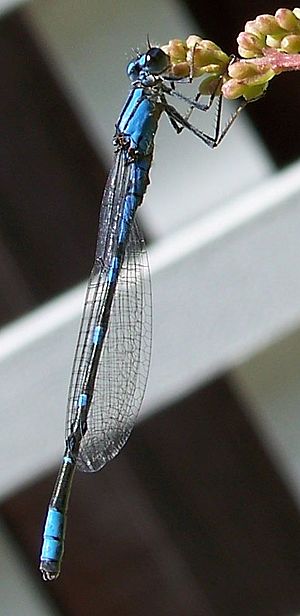Tule bluet facts for kids
Quick facts for kids Tule bluet |
|
|---|---|
 |
|
| Scientific classification | |
| Kingdom: | |
| Phylum: | |
| Class: | |
| Order: | |
| Suborder: | |
| Superfamily: |
Coenagrionoidea
|
| Family: | |
| Genus: |
Enallagma
|
| Species: |
E. carunculatum
|
| Binomial name | |
| Enallagma carunculatum Morse, 1895
|
|
The tule bluet (Enallagma carunculatum) is a type of damselfly. It belongs to the Coenagrionidae family. You can find these small, colorful insects across North America.
Contents
What Does It Look Like?
The tule bluet has a body that is both blue and black. Usually, there is more black color than blue. It has black stripes on its shoulders, called humeral stripes. These stripes are about half as wide as the blue stripes next to them. The damselfly also has small, triangle-shaped spots behind its eyes. A thin bar separates these spots.
How Big Is It?
This damselfly is about 27 to 37 millimeters long. That's roughly the length of a few paperclips lined up!
Where Does It Live?
You can find the tule bluet all over the United States. However, it is not common in the southeastern part. It also lives in many areas of southern Canada.
What Is Its Home Like?
The tule bluet likes to live near different types of water. These include:
- rivers
- lakes
- ponds
- marshes
- bogs
They are almost always found where there are lots of bulrushes. These are tall, grass-like plants that grow in wet places.
When Can You See It Flying?
You can usually see the tule bluet flying from mid-May to mid-September. Sometimes, they fly a bit later, from early July to mid-October.
What Does It Eat?
What Nymphs Eat
Young tule bluets are called nymphs. They live underwater. Nymphs eat many kinds of aquatic insects. This includes mosquito larvae, mayfly larvae, and other insect larvae that live in water.
What Adults Eat
Adult tule bluets eat many small flying insects. They catch mayflies, flies, small moths, and mosquitoes. Sometimes, they even pick up tiny insects like aphids from plants.
How Does It Live?
The tule bluet almost always lives where there are many tule plants. Tules are a type of bulrush. This is how the damselfly got its common name, "tule bluet." These damselflies can even come out of fairly deep water if bulrushes are nearby. The tule bluet can also live in water that is a bit salty or alkaline.
Reproduction
Male damselflies pick out good spots for breeding. After a male and female mate, the male stays connected to the female. They are in a special "tandem" position. The female then lays her eggs into the stems of bulrushes.
Is It Safe?
The tule bluet is a common damselfly. There are many of them, and their populations are secure. This means they are not in danger.

